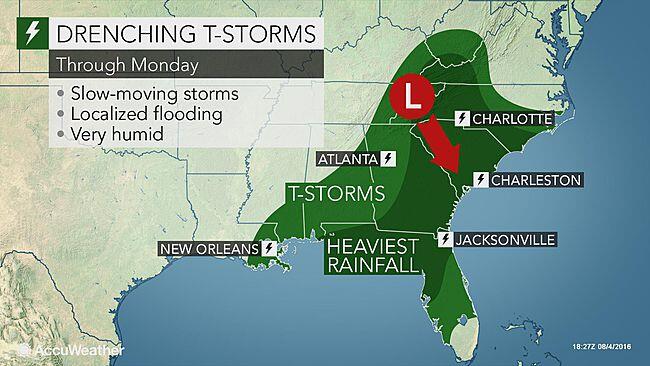Additional rounds of heavy thunderstorms will heighten the flooding threat in the southeastern United States through this weekend.
Repetitive downpours over the last few days have brought as much as 4 inches of rain to some places across the South.
“Very light winds will cause not only weather systems to move very slowly, but also individual showers and thunderstorms,” according to AccuWeather Senior Meteorologist Alex Sosnowski.
Moisture that has been trapped over the region will continue to be recycled on a daily basis through this weekend and into early next week.
“The amount of moisture in the atmosphere will make it easy for storms to produce rainfall rates of 1 to 2 inches per hour,” according to AccuWeather Meteorologist Brett Rathbun.
The greatest threat for flash flooding will extend from the Florida Peninsula to western North Carolina, southwestern Virginia and southern West Virginia.
The disruptive downpours can occur along portions of major highways such as Interstate 10, I-20, I-26, I-40, I-77, I-85 and I-95.
“Never drive through a flooded roadway,” Rathbun said.
Where storms develop or wander close to airports, airline delays can result. Should the storms impact major hubs such as Charlotte, North Carolina, Atlanta or Orlando, Florida, ripple-effect airline delays can occur elsewhere in the nation as crews and aircraft are displaced.
A wedge of slightly drier air will push southward over central and eastern parts of Virginia and North Carolina later this weekend, while high humidity and the isolated flooding downpour risk will continue farther to the southwest in the region.
Spotty showers and thunderstorms will extend across parts of the Tennessee and Mississippi valleys.
However, these thunderstorms will not be enough to help make up the deficit of rain so far this summer.
Drought-stricken areas of from central Mississippi to Tennessee and northwestern Georgia will need many days of steady rain to return to near normal.
“Some easing of the drought conditions can occur in the pattern from northeastern Georgia to western North Carolina in the pattern,” Sosnowski said.
Source: Accuweather











